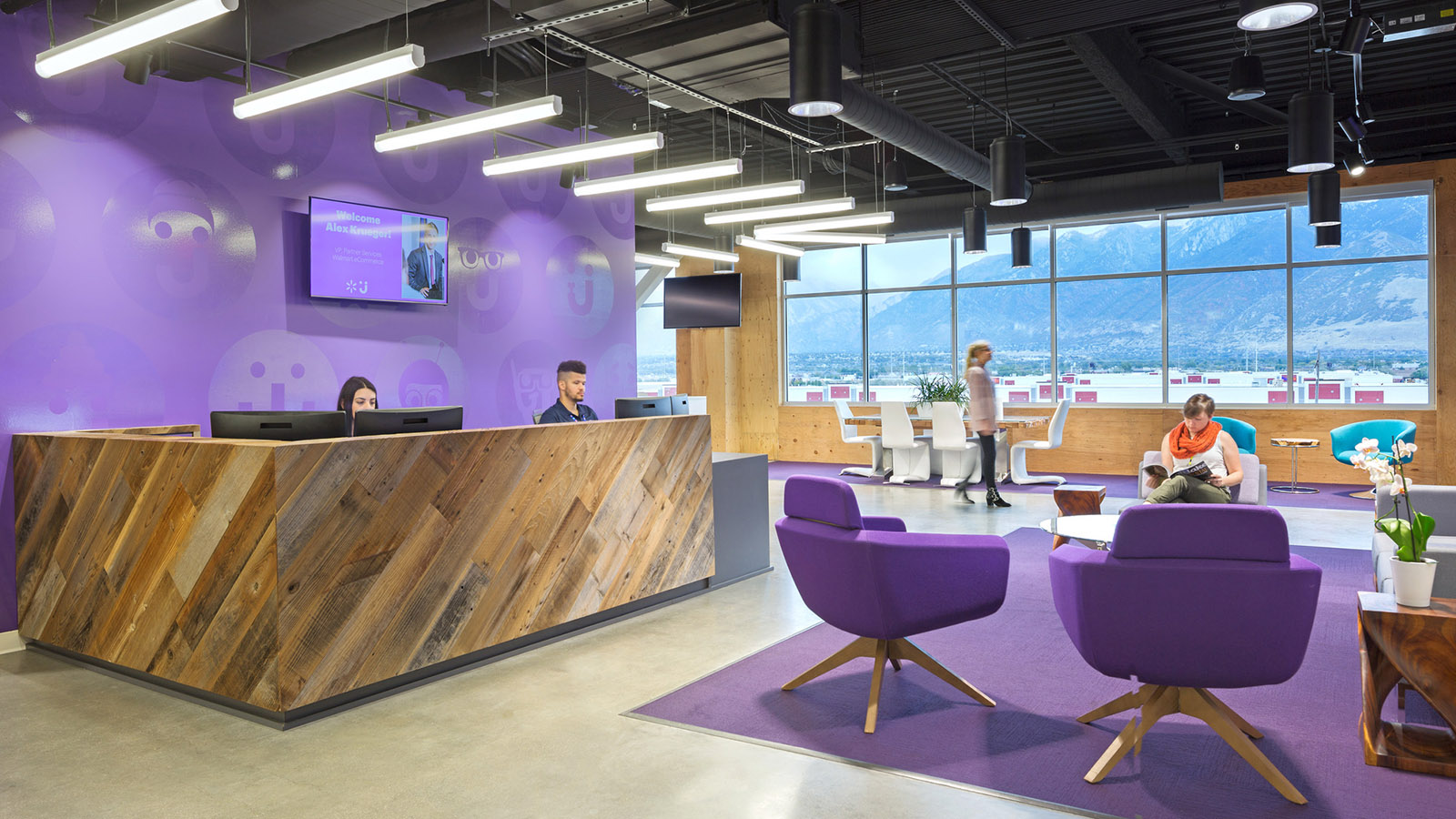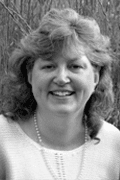By Mary Lee Duff, LEED AP, IIDA | IA Senior Director of Strategy &
Sally Augustin, PhD, Fellow, American Psychological Association
“If you’re gazing out the window, you aren’t working.”
Not so, according to scientific research...
As designers and strategists, we create work environments that drive innovation, creativity, productivity, and wellbeing. Those objectives become even more vital as industries move toward machine learning that will take over rote tasks and free employees for more creative work, entailing greater intellectual effort that brings with it a different set of pressures—mental fatigue, anxiety, and burn-out.
Our understanding of how people work best, what inspires innovation, and what nurtures wellbeing to shape the workplace as a vibrant personal and shared experience is based on scientific research. From that vantage point many long-held assumptions about productive time versus unproductive time are patently wrong, even though they’ve been held for years and are firmly institutionalized. A plethora of maxims, including “If you’re gazing out the window, you aren’t working,” and “People who take a break or daydream aren’t working,” are no longer valid, in fact they lead us in the wrong direction. Here we dispel those myths, backed by scientific research, as well as consider the science supporting the effects of positivity and of awe.
Mind Wandering
Although surmised, immediate prior mind wandering (Mann and Cadman, 2014) has now been linked to enhanced creative thinking. Among others, Gable, Hopper, and Schooler (2019) found that mind wandering can be particularly useful for overcoming mental challenges: “Professional writers and physicists reported on their most creative idea of the day, what they were thinking about and doing when it occurred, whether the idea felt like an aha moment, and the quality of the idea. Participants reported that one fifth of their most significant ideas of the day were formed during spontaneous, task-independent, mind wandering—operationalized here as (a) engaging in an activity other than working and (b) thinking about something unrelated to the generated idea... ideas that occurred during mind wandering were more likely to be associated with overcoming an impasse on a problem and to be experienced as aha moments, compared with ideas generated while on task.”
The design and architectural features of a workspace can make it more likely that users will be able to restock cognitive energy through mind wandering activities. This supports the concept of creating spaces that offer flexibility and choice, where workers can let their minds seek other paths of thinking and let go of the challenges at hand for a while. Such spaces include quiet areas, outdoor spaces, game rooms, libraries, places of refuge, nooks, and nutrition intake/break areas, to name a few. Mind wandering activities can provide real benefits for both individual work and collaboration.
Breaks
Breaks can provide an opportunity for mind wandering, although they are positive in their own right. Research on recovery from work stress emphasizes the importance of within‐day work breaks (note the use of the plural). Zhu, Kuykendall, and Zhang (2019) report that “Within‐day work breaks are significantly associated with reduced fatigue and negative affect [mood] and increased positive affect, supporting the predicted recovery effect.” Enjoying a snack, talking with a colleague about non-work related topics, contemplating an upcoming vacation, or just relaxing for a moment are all break activities that reduce stress and prepare the mind to work productively.
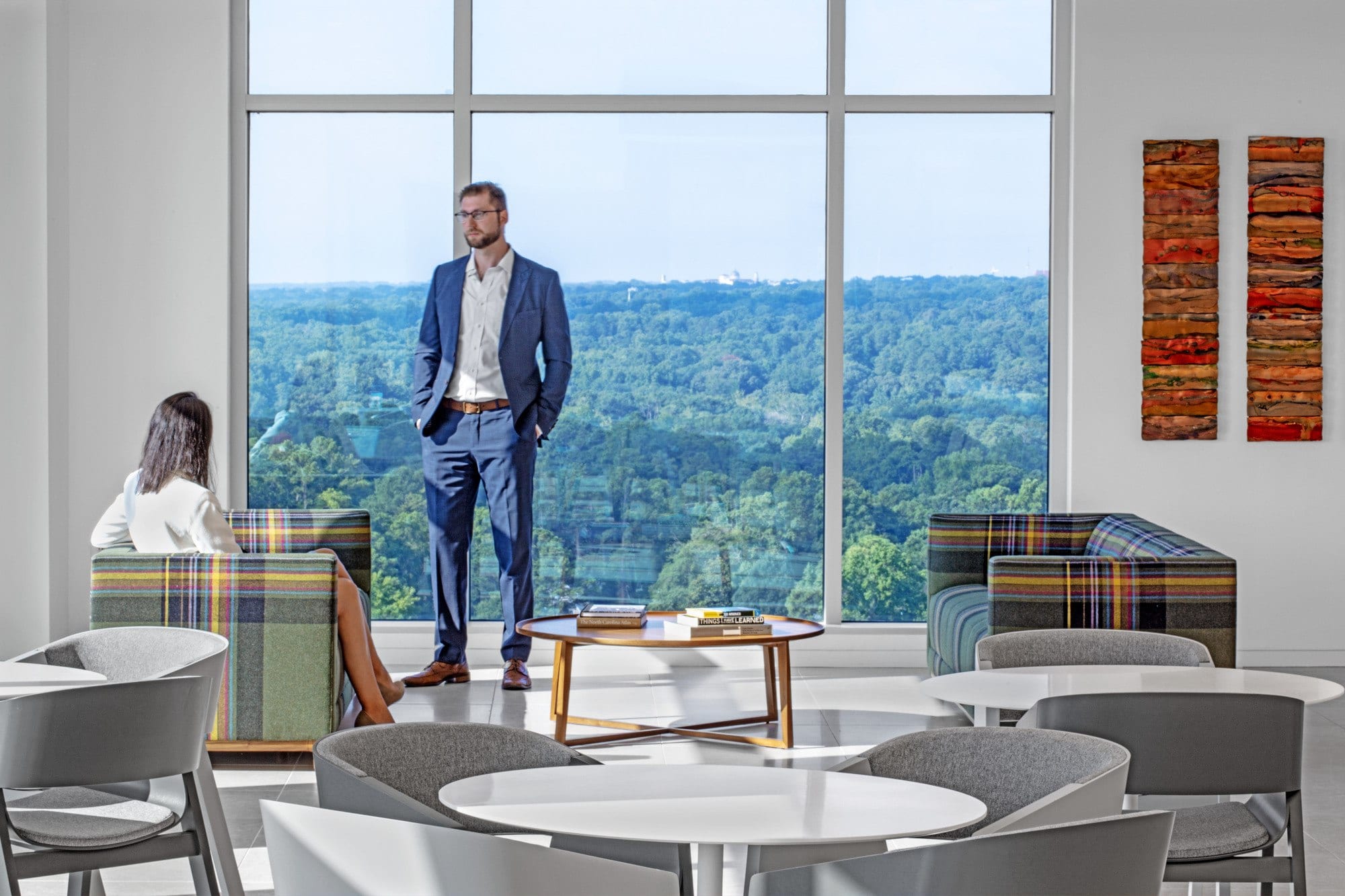
Talking with a colleague about non-work related topics is one of many types of breaks that can refresh the mind. Confidential Client, Raleigh, NC. Photography Eric Laignel
Baird, Smallwood, and colleagues (2012) found that “Taking a break involving an undemanding task improved performance on a classic creativity task far more than taking a break involving a demanding task, resting, or taking no break.” This fact supports the idea of the workplace including other break area opportunities, such as a music room or maker areas, where employees can tinker with projects ranging from building a robot to working a puzzle. These are places that offer restorative, undemanding tasks. We have increasingly been working with clients who are open and willing to offer these types of spaces to their workforce, with confidence that they’ll be used and will increase productive, creative endeavors.
Creating Positivity
When people are in a positive mood multiple desirable effects are more likely. Positive moods are linked to enhanced creative and innovative thinking (Vetch, 2018), heightened ability for problem solving and decision making (Isen, 2001), getting along better with others, and acting in more socially responsible ways (Isen, 2001). Positive moods have also been tied to greater feelings of wellbeing (Desmet, 2015). As strategists and creators of the workplace environment, we know design can affect user mood and mind-set.
One research study (Desmet, 2012) cites six ways design can support and inspire positivity in the workplace based on the extent of favorable user emotions evoked in response to:
- Object – Positive emotions due to physical qualities
- Meaning – Positive mental states resulting from associated meanings
- Interaction – Positive emotions resulting from use
- Activity – Positive emotions resulting from supported experiences
- Self – Positive user experienced emotions resulting from effects on user or other people
- Other – Positive effects resulting from how something influences how others’ actions affect us
The Benefits of Awe
People are awed by both natural and manmade environments. The experience of awe in the workplace can have a positive impact on users, and design inspires awe in a number of ways.
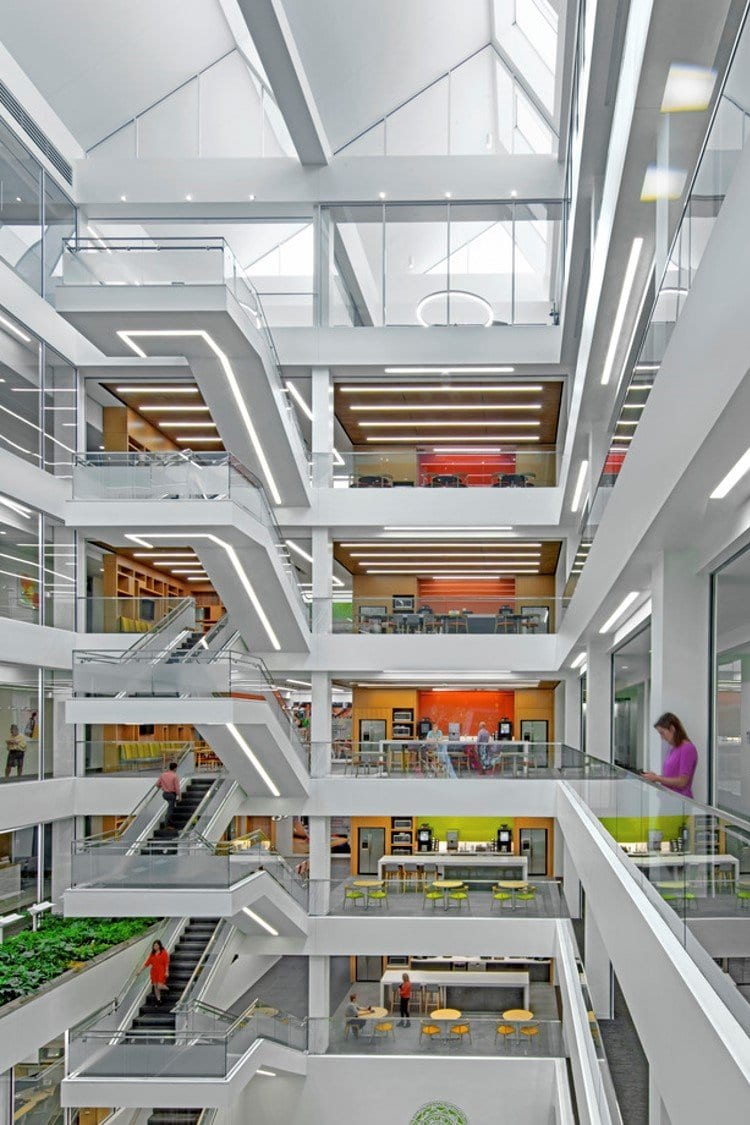
Awe can be defined as a sense of perceptual vastness experienced when coming upon something immense in size. McCormick Headquarters, Hunt Valley, MD Photographer Eric Laignel
To better understand the special meaning of vastness in this context, Shiota, Keltner, and Mossman (2007), reporting on Keltner and Haidt (2003), state that “Although the term ‘vastness’ implies great physical size, in this usage ‘vast’ describes any stimulus that challenges one’s accustomed frame of reference in some dimension. A stimulus may convey vastness in physical space, in time, in number, in complexity of detail, in ability, and even in volume of human experience... what is critical is that the stimulus dramatically expands the observer’s usual frame of reference in some dimension or domain.” In terms of workplace design a sense of awe can be felt when standing over a multi-story atrium or experiencing the magnitude and complexity of a huge open-space design, the scale of an unexpected vista, extraordinary detailing, or an interactive encounter with the environment that challenges your concept of space and the built environment. As designers we regularly create workspaces that evoke awe, especially in much of our headquarters design where an awe factor is often a client priority.
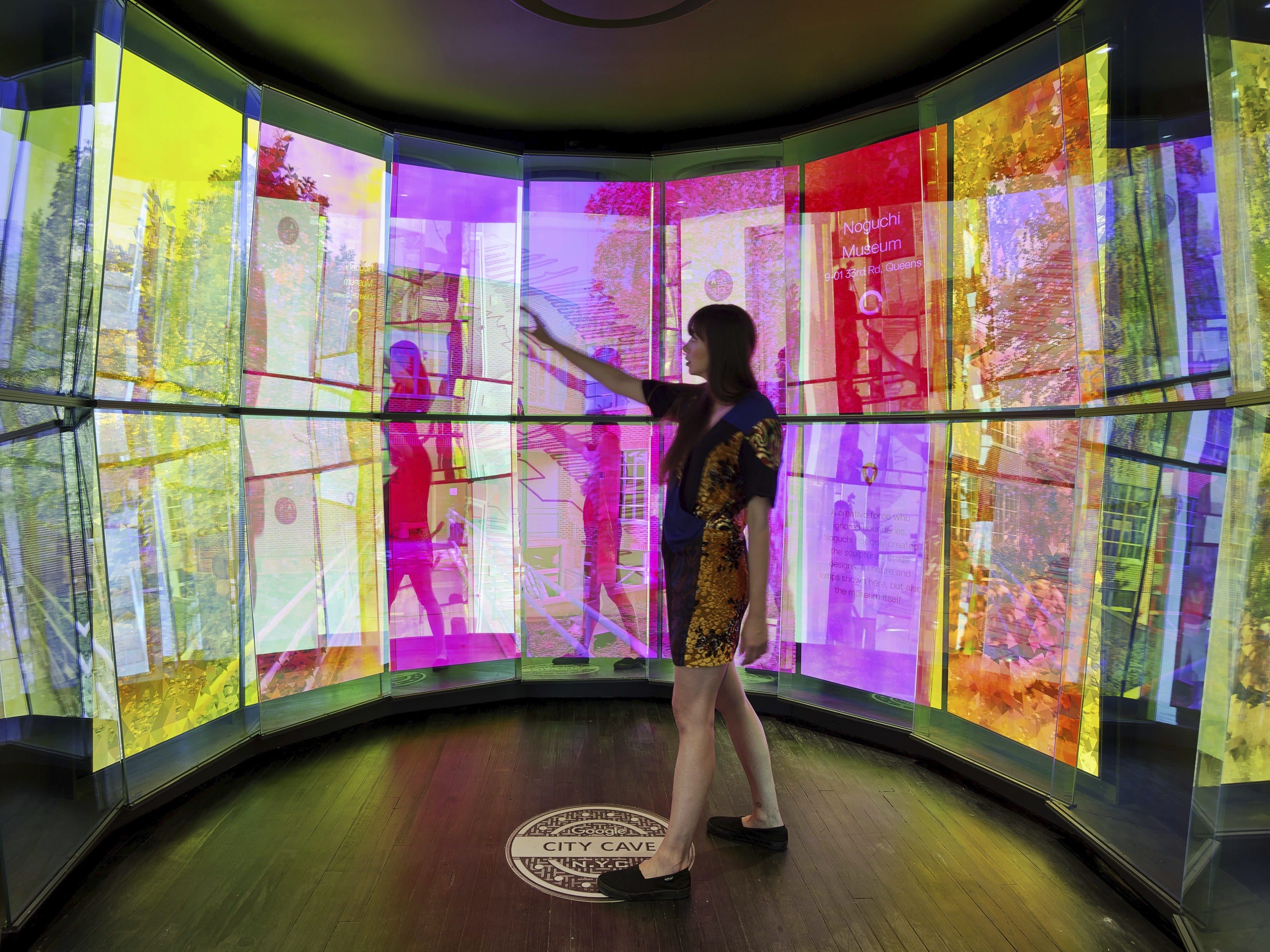
Awe can be manmade and engaging. Here images of the Big Apple pop up in response when the user chooses specific emotion-related search terms. Google, New York City. Photography © Eric Laignel
The benefits of awe are multiple and include:
- More effective and efficient processing of cognitive information (Shiota, Keltner, and Mossman, 2007).
- Greater creativity (Yeung, Tschetter, and Shiota, 2011)
- Feeling less rushed and impatient and a greater willingness to voluntarily help other people (Rudd, Vohs, and Aaker, 2012)
- More attention to the welfare of others (Piff, Dietze, Feinberg, Stancato, and Keltner 2015) and collective concerns (Bai et al., 2017)
- Having a more open mind (Danvers and Shiota, 2017)
- Presenting a more balanced view of personal strengths and weaknesses (Stellar, Gordon, Anderson, Piff, McNeil, and Keltner, 2018)
Meditation
The rhetoric around the positive aspects of mindfulness, the most basic form of meditation, plus the misconception that meditation is really non-productive time continues. But the simple truth is that meditation changes the structure of the brain, a fact known by some for about 3,000 years and now verified by scientific research. Training and the regular practice of meditation have been linked to physical and mental wellbeing; we’ve covered this in previous posts.
The workspace can support meditation with a relatively straightforward expenditure of resources. Training programs and setting aside time during the workday specifically for meditation are choices companies can and are making that yield great benefits in terms of staff wellbeing, productivity and, therefore, ultimately a company’s bottom line.
Conclusion
In conclusion, it is not enough to simply design for variety and choice in the workplace. It is important to think through the implications of the types of spaces provided and how they support the very necessary and productive activities that are important to creativity and thought processes as well as workflow. We now understand the science behind the time needed to meditate, reflect, ponder, and mind wander as well as the environments that support and invite these activities to flow.
References
Yang Bai, Laura Maruskin, Serena Chen, Amie Gordon, Jennifer Stellar, Galen McNeil, Kaiping Peng, and Dacher Keltner. 2017. “Awe, the Diminished Self, and Collective Engagement: Universals and Cultural Variations in the Small Self.” Journal of Personality and Social Psychology, vol. 113, no. 2, pp. 185-209.
Benjamin Baird, Jonathan Smallwood, Michael Mrazek, Julia Kam, Michael Franklin, and Jonathan Schooler. 2012. “Inspired by Distraction: Mind Wandering Facilitates Creative Incubation.” Psychological Science, vol. 23, no. 10, pp. 1117-1122.
Alexander Danvers and Michelle Shiota. 2017. “Going Off Script: Effects of Awe on Memory for Script-Typical and –Irrelevant Narrative Detail.” Emotion, vol. 17, no. 6, pp. 938-952.
Pieter Desmet. 2012. “Faces of Product Pleasure: 25 Positive Emotions in Human-Product Interactions.” International Journal of Design, vol. 6, no. 2, pp. 1 – 29.
Pieter Desmet. 2015. “Design for Mood: Twenty Activity-Based Opportunities to Design for Mood Regulation.” International Journal of Design, vol. 9, no. 2, pp. 1 – 19.
Shelly Gable, Elizabeth Hopper, and Jonathan Schooler. 2019. “When the Muses Strike: Creative Ideas of Physicists and Writers Routinely Occur During Mind Wandering.” Psychological Science, vol. 30, no. 3, pp. 396-404.
A. Isen. 2001. “An Influence of Positive Affect on Decision Making in Complex Situations: Theoretical Issues with Practical Implications.” Journal of Consumer Psychology, vol. 11, no. 2, pp. 75-85.
Jennifer Vetch. 2018. "How and Why to Assess Workplace Design: Facilities Management Supports Human Resources." Organizational
Dynamics, vol. 47, pp. 78-87.
Yannick Joye and Jan Verpooten. 2013. “An Exploration of the Functions of Religious Monumental Architecture from a Darwinian Perspective.” Review of General Psychology, vol. 17, no. 1, pp. 53-68.
Sandi Mann and Rebekah Cadman. 2014. “Does Being Bored Make Us More Creative?” Creative Research Journal, vol. 26, no. 2, pp. 165-173.
Benjamin Meagher. 2018. “Deciphering the Religious Orientation of a Sacred Space: Disparate Impressions of Worship Settings by Congregants and External Observers.” Journal of Environmental Psychology, vol. 55, pp. 70-80.
Melanie Rudd, Kathleen Vohs, and Jennifer Aaker. 2012. “Research Paper No. 2095: Awe Expands People’s Perception of Time, Alters Decision Making, and Enhances Well-Being.” http://gsbapps.stanford.edu/researchpapers/library/RP2095-1.pdf
M. Shiota, D. Keltner, and A. Mossman. 2007. "The Nature of Awe: Elicitors, Appraisals, and Effects on Self-Concept." Cognition and Emotion, vol. 21, pp. 944-963.
Jennifer Stellar, Amie Gordon, Craig Anderson, Paul Piff, Galen McNeil, and Dacher Keltner. 2018 “Awe and Humility.” Journal of Personality and Social Psychology, vol. 114, no. 2, 258-269.
Wan Yeung, Ashley Tschetter, Michelle Shiota. 2011. “Differential Effects of Distinct Positive Emotions on Creativity.” APA Division 8, Society for Personality and Social Psychology Conference, January 27-29, http://dx.doi.org/10.1037/e634112013-913.
Ze Zhu, Lauren Kuykendall, and Xichao Zhang. 2019. “The Impact of Within-Day Work Breaks on Daily Recovery Processes: An Event-Based Pre-/Post-Experience Sampling Study.” Journal of Occupational and Organizational Psychology, vol. 92, no. 1, pp. 191-211.
Sally Augustin, PhD, is a practicing environmental psychologist and a principal at Design With Science. She focuses on integrating science-based insights to develop recommendations for the design of places, objects, and services that support desired cognitive, emotional, and physical outcomes/experiences. Her clients include design firms, manufacturers, and service providers worldwide.
Dr. Augustin is a Fellow of the American Psychological Association (APA) and holds leadership positions in professional organizations including the APA and the Environmental Design Research Association. The author of two books, her work has been discussed in the The New York Times, The Wall Street Journal, The Guardian, Forbes, and Psychology Today, as well as on television and radio. In North America, Europe, and Asia, she is a frequent speaker and has addressed the annual meeting of both the American Institute of Architects and the APA, as well as events such as WorkTech, NeoCon/IIDEX, and many more.
